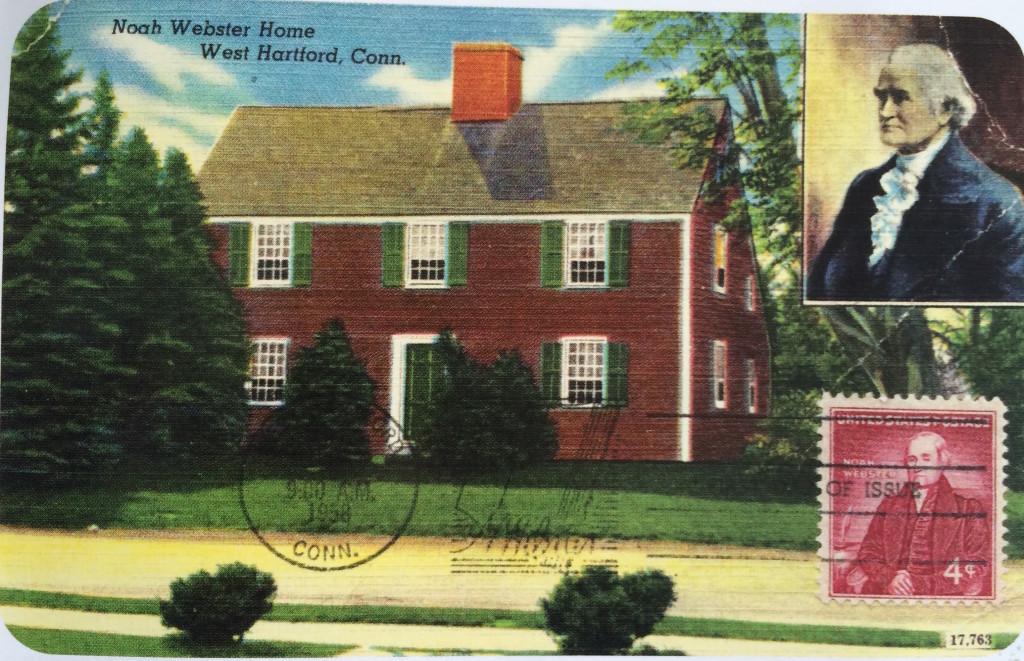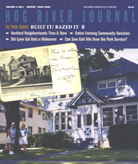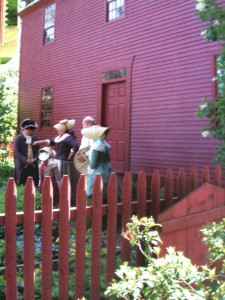By Frederick W. Hamilton (c) Connecticut Explored Inc. Winter 2005/2006

1950s postcard of the Noah Webster House when it was a private home. Courtesy of the Noah Webster House
The year was 1910. My mother and dad were living with my brother in a rented house in Farmington, Connecticut. Family lore holds that it was a beautiful day, the kind that promotes thinking about expansion and the future. There had been some talk about buying a house, having a larger family, and the prospect of happy and successful years ahead. During breakfast, my mother spotted an advertisement in The Hartford Courant that described a house for sale on South Main Street in West Hartford. The ad mentioned that the house was the birthplace of Noah Webster, author of the first American dictionary.
My mother suggested to Dad that he consider looking at the house on his way to work. His interest aroused, Father got off the trolley car at West Hartford Center and walked a mile south. He found the house located on 11 acres with about 500 feet of street frontage; a view to the east overlooked Hartford, and the land to the west settled down to a small brook. To the rear were run-down outhouses and barns. The house needed considerable attention; after all, it was then more than 150 years old.
That evening, Mother met Dad at his office, and after dinner they attended a show at Unity Hall on Pratt Street. Afterward, they boarded the trolley car to return home. It then occurred to Mother that she had heard nothing about Dad’s visit to the house. He described it in unflattering terms. His mention of a view interested my mother, though. She suggested that it might be fun to look at the house and its lovely view in the moonlight.
The next morning Dad made an offer, and the house and 11 acres were theirs.
Now the house had to be made habitable. The flooring on the first level needed replacement. A coal furnace was installed in the dirt cellar, and radiators were added in each room. The Hamilton family—mother, father, and son—then moved in. During the next three years the resident population increased by two: first me, and then my sister, Grace. In the meantime, my parents were planning to build a much larger house on the vacant land to the northwest. We moved into this new home in 1913.
For the next 24 years the Webster house lived a very quiet life. In 1937, the house escaped from its doldrums. Grace married, and she and her husband moved in, adding a new furnace and improved heating. In the fall of 1938, I became engaged to Jane, with plans to marry in the summer of 1939. The persuasion we used to hasten my sister’s departure was disgraceful, but it worked. When we married, we moved in and three children were born to us while we lived there.
We often have been asked to describe living in the house where one of our country’s greatest educators and the father of our universal American language lived. Our answers were very practical. It was too hot in the summer and much too cold in the winter. In the winter, damp towels left on the outside wall rack in the one and only bathroom were crisply frozen in the morning. On the other hand, when we entertained, the house exuded a feeling of closeness and warmth. The fireplaces never smoked, and they enhanced the feeling of welcome.
 The house occasionally attracted the inquiring public. In the early 1930s, the Daughters of the American Revolution asked permission to designate the house as historic by placing a bronze plaque on the exterior. Later, the State of Connecticut added a street-side commemorative sign. Thereafter, on occasion, we would look up while sitting in our parlor to see a face in the window, or there would be a rap on the door with a visitor asking “Is the house open?” We would try to accommodate such visitors, saying in an unusually loud voice, “It is not a museum, but we’d be delighted to show it.” This was a signal for our children to shove all their misplaced clothes and junk under their beds, since the house had no closets. Occasionally primary-grade students from West Hartford would make educational pilgrimages to the house, and Jane would become a docent for a few hours.
The house occasionally attracted the inquiring public. In the early 1930s, the Daughters of the American Revolution asked permission to designate the house as historic by placing a bronze plaque on the exterior. Later, the State of Connecticut added a street-side commemorative sign. Thereafter, on occasion, we would look up while sitting in our parlor to see a face in the window, or there would be a rap on the door with a visitor asking “Is the house open?” We would try to accommodate such visitors, saying in an unusually loud voice, “It is not a museum, but we’d be delighted to show it.” This was a signal for our children to shove all their misplaced clothes and junk under their beds, since the house had no closets. Occasionally primary-grade students from West Hartford would make educational pilgrimages to the house, and Jane would become a docent for a few hours.
Finally, after 20 years of happiness, it was time once more for a change. We acquired almost two acres of the original Webster property to the south and rear of the house, and, in 1960, we moved 200 feet to our new home.
The Webster house was vacant again, and the Hamilton family began to worry about it. In 1962, we decided to approach the Town of West Hartford; to our delight, the town accepted our gift of the Webster house. For more than two years, however, the vacant house remained uncared for and untouched. Then Dick Crampton, a thoughtful and active town councilman, became interested, as did Gordon Bennett, whose wife had once lived next door. They formed a group that eventually became the Noah Webster Foundation. The town leased the house to the foundation for $1 a year. A recognized restoration artisan was contracted, and work commenced.
 Fortunately, any wall or cupboard changes made in the past were clearly visible in the old plaster of the ceilings and walls. When we lived there, all the floors slanted away from the center chimney. The slant was so steep, (because all of the outer sills were partially or wholly rotted out) that my son’s electric trains could not make it back up around the track. The flooring on the first floor was replaced with wide boards similar to the originals, purchased from a dismantled colonial tavern.
Fortunately, any wall or cupboard changes made in the past were clearly visible in the old plaster of the ceilings and walls. When we lived there, all the floors slanted away from the center chimney. The slant was so steep, (because all of the outer sills were partially or wholly rotted out) that my son’s electric trains could not make it back up around the track. The flooring on the first floor was replaced with wide boards similar to the originals, purchased from a dismantled colonial tavern.
Over the years all five of the fireplaces had been altered. Most had been made more shallow to deflect more heat into the room. The bricks added for this purpose were now removed. One discovery was spectacular. In the 18th-century kitchen was a five-foot-wide fireplace flanked by wood paneling. It was determined that a panel on the left side was a later addition. When it was removed, out tumbled rubble of all kinds: dirt, sand, broken brick, and stone. Behind was the course of brick marking the original fireplace. Once restored, the fireplace, which in its earliest days had been the only cooking “stove” for the home, again contained its two large brick baking ovens. One was in perfect condition, and the other required only minor repairs. This “walk-in” cooking and heating fireplace became one of the chief attractions of the museum after it opened to the public in 1965.
Frederick Hamilton lived on the Noah Webster House property for 80 years. He retired as vice president at Travelers Insurance Company in 1976 and died in 2003. Published by permission of Jane Hamilton, wife of the late Frederick W. Hamilton.
Explore!
The Noah Webster House and West Hartford Historical Society
227 Main Street, West Hartford
Noahwebsterhouse.org, 860-521-5362
